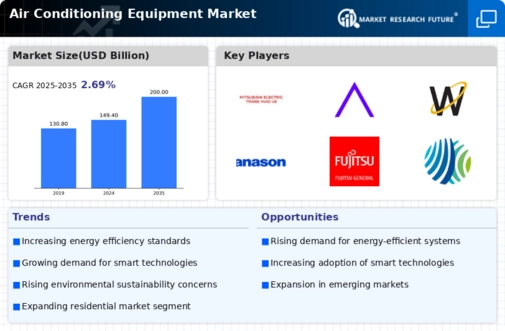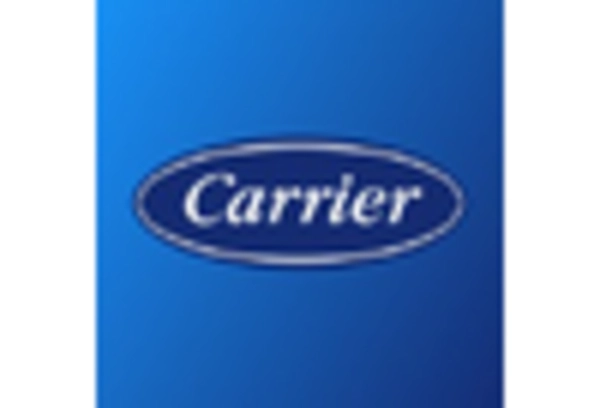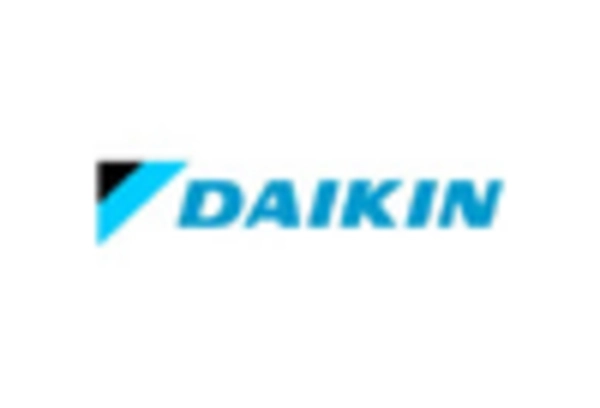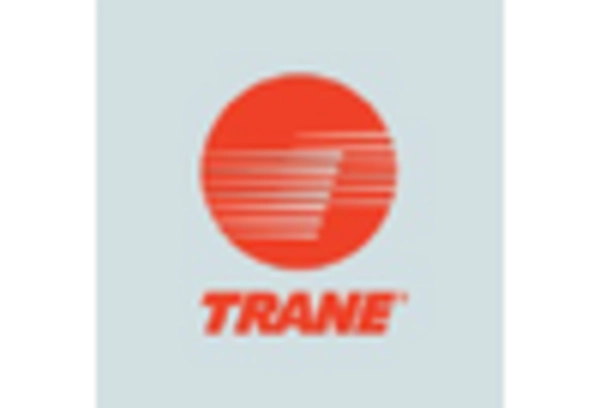Urbanization and Population Growth
Urbanization and population growth are pivotal factors influencing the Air Conditioning Equipment Market. As more individuals migrate to urban areas, the density of housing and commercial spaces increases, leading to a higher demand for air conditioning systems. Data indicates that urban populations are expected to rise significantly, with projections suggesting that by 2050, nearly 68% of the world's population will reside in urban areas. This urban shift necessitates efficient cooling solutions to ensure comfort in densely populated environments. Consequently, manufacturers are focusing on developing compact and efficient air conditioning units tailored for urban settings, thus propelling the growth of the Air Conditioning Equipment Market.
Rising Temperatures and Climate Change
The Air Conditioning Equipment Market is experiencing a notable surge in demand due to rising temperatures and climate change. As average global temperatures continue to increase, the need for effective cooling solutions becomes more pressing. According to recent data, the demand for air conditioning units is projected to grow at a compound annual growth rate of approximately 5.5% over the next several years. This trend is particularly evident in regions that have historically not relied heavily on air conditioning, as more consumers recognize the necessity of climate control in their homes and workplaces. Consequently, manufacturers are responding by innovating and expanding their product lines to meet this growing demand, thereby driving the Air Conditioning Equipment Market forward.
Increased Awareness of Indoor Air Quality
Increased awareness of indoor air quality is emerging as a significant driver in the Air Conditioning Equipment Market. Consumers are becoming more conscious of the impact of air quality on health and well-being, leading to a heightened demand for air conditioning systems that incorporate advanced filtration and purification technologies. Research indicates that poor indoor air quality can lead to various health issues, prompting individuals and businesses to invest in air conditioning solutions that enhance air quality. This trend is likely to propel the growth of the Air Conditioning Equipment Market as manufacturers respond by integrating air purification features into their products, thereby addressing consumer concerns and preferences.
Technological Advancements in HVAC Systems
Technological advancements in HVAC systems are transforming the Air Conditioning Equipment Market. Innovations such as variable refrigerant flow (VRF) systems, smart thermostats, and IoT integration are enhancing the efficiency and functionality of air conditioning units. These technologies not only improve energy efficiency but also provide users with greater control over their indoor environments. The market for smart air conditioning systems is expected to witness substantial growth, with estimates suggesting a potential increase of over 20% in the next five years. As consumers become more tech-savvy, the demand for advanced air conditioning solutions that offer convenience and energy savings is likely to drive the Air Conditioning Equipment Market further.
Regulatory Standards and Energy Efficiency Mandates
Regulatory standards and energy efficiency mandates are playing a crucial role in shaping the Air Conditioning Equipment Market. Governments worldwide are implementing stricter regulations aimed at reducing energy consumption and greenhouse gas emissions. These mandates often require manufacturers to develop more energy-efficient air conditioning systems, which in turn drives innovation and investment in the sector. For instance, the introduction of energy efficiency labels and standards has encouraged consumers to opt for high-efficiency models, thereby influencing purchasing decisions. As a result, the Air Conditioning Equipment Market is witnessing a shift towards more sustainable and efficient products, aligning with global energy conservation goals.


















Leave a Comment